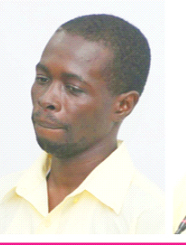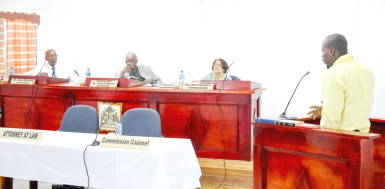Although unable to identify who started the deadly fire that killed 17 at the Camp Street prison, two inmates yesterday testified that it was the alleged assault on fellow inmates by officers that led to the unrest that preceded the blaze.
Murder accused Errol Kesney and manslaughter accused Dwayne Lewis took the stand when the Commission of Inquiry (CoI) into the March 3rd prisoner deaths commenced at the Department of Public Service building on Waterloo Street, Georgetown.
Kesney, who is still awaiting the commencement of the preliminary inquiry into the charge against him, and Lewis, who has been committed to stand trial at the High Court, appeared before Chairman of the commission, Justice James Patterson and Commissioners Dale Erskine, a former prisons director, and Merle Mendonca, a human rights activist.

Questions were directed to the men by Justice Patterson and Erskine as the Commission’s Counsel was not present at the hearing yesterday.
Lewis related that on March 2nd, the day before the fire, a search was conducted around 3.30pm. The inmates were advised to pick up what they needed and exit the dormitory. When the search concluded, the ranks, made up of prison officials and Guyana Police Force officers, exited with two margarine buckets filled with cellphones and marijuana.
On the same night, Lewis had been asleep in the Capital “A” Division of the Camp Street prison when he awoke due to water spilling on his mattress. He saw fire outside of the dormitory and could hear the inmates shouting for freedom and advocating for speedier trials at the courts. He said some of the prisoners were aggrieved because their cellphones and drugs—items they used for comfort and to keep themselves calm while incarcerated— were taken away. Lighters, home-made cutlasses and what was referred to as “local alcohol” were also seized during the raid.
This last search, he revealed, had been the longest to ever take place. He said that searches generally occur once every three months. Lewis has been imprisoned for the past eight.
‘They beating them’
Neither Kesney nor Lewis could say for sure who started the fire on March 3rd. But according to Kesney, the day after the first search had occurred, when the fire service reportedly put out nine fires at the prison, he awoke around the hours of 9am, when officers came and told them to pack their things. The men, around 70 in number by estimates of the two, were instructed to leave the quarters five by five.
Kesney said that when the first five were escorted downstairs to the prison yard, the officers began manhandling them and a shout came from a prisoner, who stated, “They beating them man! They beating them man! Leh we don’t go out, they gon beat all a we!” He said he saw them lift one of the men into the air and they were beating another.

Lewis had earlier shared a similar story, while stating that some of the prisoners were “behaving at a rate” because they had witnessed officers harassing prisoners. He recalled that one prisoner, Collis Collisson, called “juvenile” had been beaten into an unconscious state by a prison warden. He could not, however, identify this warden. Lewis related that he saw Collisson at the prison on Monday but has not seen him since.
The fire
According to Kesney, when panic broke out among the prisoners about the harassment that was occurring in the prison yard, approximately 40 prisoners had already been escorted out of the division. Kesney, at the time, had still been in the dormitory packing his things to leave. He recalled then hearing a call for the door to be locked. He stated that this instruction was conveyed by a short officer in khaki they refer to as “Hooligan.”
After the door was shut, he saw that someone had made a hole in the wall between the A and B divisions of the Capital section. Himself, Jermaine Otto (now deceased) and another he did not name, jumped through the hole into Capital B. He then heard someone shout, “Watch Mr. Samuels with a gun.” Samuels, he stated, who he knows as the “OC,” passed an order for the officers to “hurry and lock back the door.” After hearing this, Kesney related that he jumped back through the hole, returning to Capital A. It was only then that he saw a small fire had started in the room. (Deputy Prisons Director Gladwin Samuels was last week sent on six weeks of leave in the wake of complaints by inmates after the fire.)
Lewis was able to state that the fire had in fact begun in the middle of the room. He could not relate how the fire started but said that when the area began to smoke, they attempted to put out the flames but there was no water coming into the facility.
Lewis said that six cans of tear gas were thrown into the division through holes in the wall, which were approximately 5×5 in inches, and they burned their eyes and skin. He stated that he ran to the entrance calling for help but found that the door had been closed. Eventually, he made his escape by jumping through the hole in the wall around which the fire had been blazing. Lewis, who said he was the first prisoner to be escorted out and taken to the hospital, sustained burns to his lower body.
While Lewis made his escape through the fire, Kesney was saved after he retreated to the back of the room. He recalled how someone had come with an extinguisher and attempted to put the fire out but as quickly as it was sprayed, he saw thick black smoke rising from the floor. Persons at this point had started yelling to be let out and his skin had started to burn, so he ran to the back of the room, where he said there was a little ventilation.
The man stated that there had been two ex-soldiers in the dorm at the time, one being Rayon Paddy, the first confirmed death on the fateful day.
“Paddy said, “Is gas they throwing, stay low,”” Kesney recounted. Paddy then advised the men to take their jerseys, wet them, and put it over their faces.

Kesney said that even at this point, all he could see was smoke. However, Paddy had crawled under the blanket of smoke to help one of the inmates and when he returned, he saw that his skin appeared to be burning off.
Kesney said that it was an inmate known to the prisoners as “The Spirit” along with others who eventually aided their escape. They came in spraying water and told the men, who were still huddled in a corner, to run to the front as the door was now open. Kesney related that none of the persons who were in the corner with him that day had died.
Both Kesney and Lewis said they had seen or heard no attempts from prison officials to open the door or put out the fire. All they could hear were the screams of their fellow inmates.
Grievances
The inmates, given the opportunity to air their grievances about the situation inside the prison, related to the Commission problems most commonly faced by the prisoners. Among these were cramped sleeping arrangements. They said the divisions are overcrowded and many prisoners are forced to sleep on the cold, hard floor as there are not enough mattresses available. Kesney and Lewis both related that they had slept for months on the floor until a space became available. This only happened because an inmate was granted bail.
Limited phone calls was also a grievance. There were complaints about prisoners not being able to access phones unless there was a serious occurrence. According to the men, calls were provided by their fellow inmates, who would lend them their cellphones so they could keep in touch with their family members. This is the system used by most prisoners. Furthermore, neither man seemed to be aware of the number of phone calls they were entitled to at the prison.
Unsanitary food was also a source of discomfort. There were complaints of frequently finding foreign objects in food, such as bricks and paddy dust. Concern was also expressed about the condition of the food handlers, who they claimed appeared quite dirty and unkempt.
One of the prisoners related that a request for soap and toilet paper from the prison officials had once taken months to be granted. The supplies, he said, only came through after hampers were brought to the prison.
The prisoners also said that they are on lockdown the entire week, save for the few hours they are taken away to visit the courts, the half hour they are allotted on Thursdays and Sundays to visit the chapel located outside the cell block, and the one hour of sunlight they are awarded on Mondays. This time they use for recreational activities, such as cricket and football, but aside from this, there is not much else at their disposal.
It was reported too that there are usually no officers outside on the catwalk unless they are there to bring food, to take someone to court, or to get a count of the prisoners. It was stated that this often results in the escalation of altercations between prisoners as there is no one readily available to offer assistance when they call for help. One of the prisoners related that four officers work the entire Capital division, which he estimates to house in excess of 200 prisoners, although he did not see any problem with the ratio.
The CoI continues today, when more inmates are expected to testify.
According to the Terms of Reference for the inquiry, the Commission has been constituted to enquire into all the circumstances surrounding the death of the 17 prisoners and to make recommendations on any action that should be taken to avoid a recurrence. It will also investigate, examine and report on the causes, circumstances and conditions that led to the fatal disturbances and also determine whether the conduct of the staff of the Guyana Prison Service in any way contributed to the prisoner deaths.





